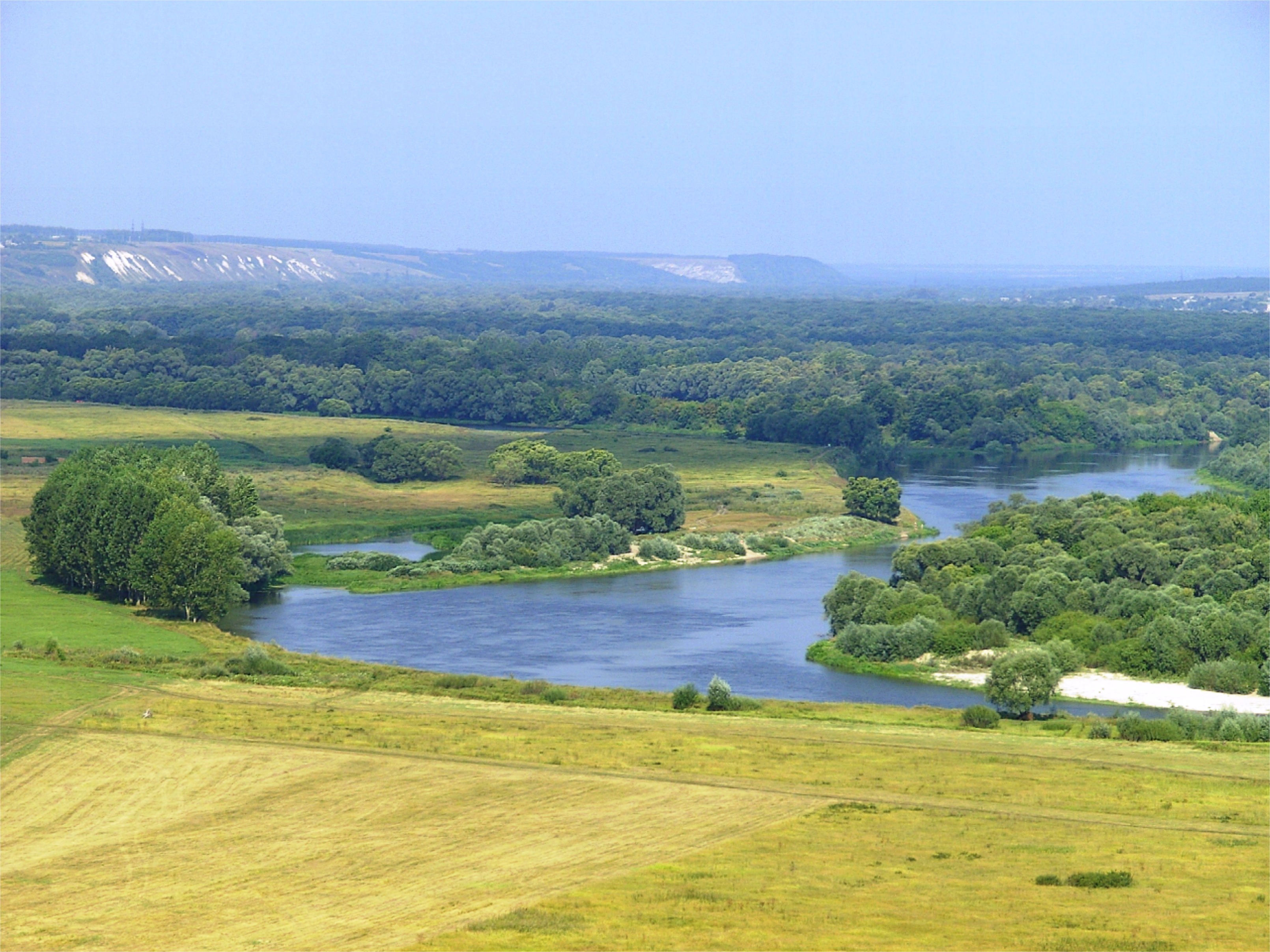
Don (river)
The Don (Russian: Дон) is the fifth-longest river in Europe. Flowing from Central Russia to the Sea of Azov in Southern Russia, it is one of Russia's largest rivers and played an important role for traders from the Byzantine Empire.
For other uses, see Don River (disambiguation).Don
Дон (Russian)
238 m (781 ft)
Kagal'nik, Rostov Oblast
0 m (0 ft)
1,870 km (1,160 mi)
425,600 km2 (164,300 sq mi)
935 m3/s (33,000 cu ft/s)
Its basin is between the Dnieper basin to the west, the lower Volga basin immediately to the east, and the Oka basin (tributary of the Volga) to the north. Native to much of the basin were Slavic nomads.[1]
The Don rises in the town of Novomoskovsk 60 kilometres (37 mi) southeast of Tula (in turn 193 kilometres (120 mi) south of Moscow), and flows 1,870 kilometres to the Sea of Azov. The river's upper half ribbles (meanders subtly) south; however, its lower half consists of a great eastern curve, including Voronezh, making its final stretch, an estuary, run west south-west. The main city on the river is Rostov-on-Don. Its main tributary is the Seversky Donets, centred on the mid-eastern end of Ukraine, thus the other country in the overall basin. To the east of a series of three great ship locks and associated ponds is the 101-kilometre (63 mi) Volga–Don Canal.
History[edit]
The name Don could stem from the Avestan word dānu- ("river, stream").[2] According to the Kurgan hypothesis, the Volga-Don river region was the homeland of the Proto-Indo-Europeans around 4,000 BC. The Don river functioned as a fertile cradle of civilization where the Neolithic farmer culture of the Near East fused with the hunter-gatherer culture of Siberian groups, resulting in the nomadic pastoralism of the Proto-Indo-Europeans.[3] The east Slavic tribe of the Antes inhabited the Don and other areas of Southern and Central Russia.[4][5] The area around the Don was influenced by the Byzantine Empire because the river was important for traders from Byzantium.[6]
In antiquity, the river was viewed as the border between Europe and Asia by some ancient Greek geographers.[7][8][9] In the Book of Jubilees, it is mentioned as being part of the border, beginning with its easternmost point up to its mouth, between the allotments of the sons of Noah, that of Japheth to the north and that of Shem to the south.[10][note 1] During the times of the old Scythians it was known in Greek as the Tanaïs (Τάναϊς) and has been a major trading route ever since. Tanais appears in ancient Greek sources as both the name of the river and of a city on it, situated in the Maeotian marshes.[note 2] Greeks also called the river Iazartes (Ἰαζάρτης).[12]
Pliny gives the Scythian name of the Tanais as Silys.[13]
According to an anonymous Greek source, which historically (but not certainly) has been attributed to Plutarch, the Don was home to the legendary Amazons of Greek mythology.[14]
The area around the estuary has been speculated to be the source of the Black Death in the mid-14th century.[15]
While the lower Don was well known to ancient geographers, its middle and upper reaches were not mapped with any accuracy before the gradual conquest of the area by the Tsardom of Russia in the 16th century.
The Don Cossacks, who settled the fertile valley of the river in the 16th and 17th centuries, were named after the river.[16]
The fort of Donkov was founded by the princes of Ryazan in the late 14th century. The fort stood on the left bank of the Don, about 34 kilometres (21 mi) from the modern town of Dankov, until 1568, when it was destroyed by the Crimean Tatars, but was soon restored at a better fortified location. It is shown as Donko in Mercator's Atlas (1596).[17]
Donkov was again relocated in 1618, appearing as Donkagorod in Joan Blaeu's map of 1645.[18]
Both Blaeu and Mercator follow the 16th-century cartographic tradition of letting the Don originate in a great lake, labeled Resanskoy ozera by Blaeu. Mercator follows Giacomo Gastaldo (1551) in showing a waterway connecting this lake (by Gastaldo labeled Ioanis Lago, by Mercator Odoium lac. Iwanowo et Jeztoro) to Ryazan and the Oka River. Mercator shows Mtsensk (Msczene) as a great city on this waterway, suggesting a system of canals connecting the Don with the Zusha (Schat) and Upa (Uppa) centered on a settlement Odoium, reported
as Odoium lacum (Juanow ozero)[19] in the map made by Baron Augustin von Mayerberg, leader of an embassy to the Tsardom of Russia in 1661.
In modern literature, the Don region was featured in the work And Quiet Flows the Don by Mikhail Aleksandrovich Sholokhov, a Nobel-prize winning writer from the stanitsa of Veshenskaya.[20]